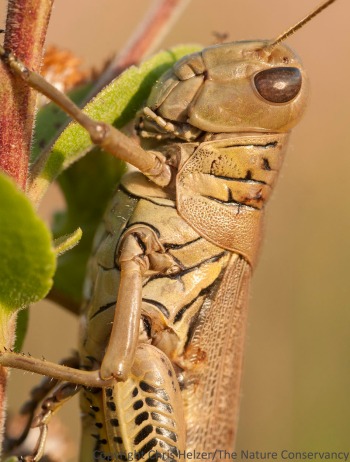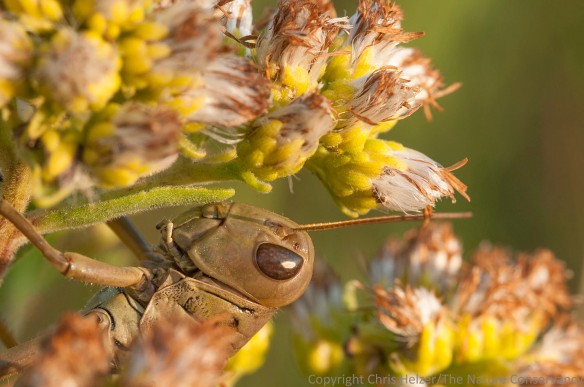Who could be mad at these big beautiful brown eyes?
As it turns out, lots of people can.
The differential grasshopper is one of a long list of native North American species, headlined by white-tailed deer and raccoons, that have adapted very well to today’s agricultural landscapes. Whether you call these species adaptable generalists or pests probably depends upon whether or not they’re eating your sweet corn. Regardless, you have to admire (or at least recognize) the traits that allowed them to thrive under changing habitat conditions that have pushed many other native species to the brink of extinction.

The olive-greenish color and the strong herringbone pattern on its back leg helps distinguish the adult differential grasshopper from other species.
Before Europeans took over the continent, differential grasshoppers lived mainly in low grasslands, feeding on a wide variety of grasses and wildflowers – but, purportedly, with a particular affinity for giant ragweed. When the landscape began changing to one dominated by rowcrops, alfalfa, and short-grazed grasslands, it basically created heaven on earth for differential grasshoppers. Today, they are abundant enough that they can be found almost anywhere across the landscape (at least in Nebraska). Apparently, they can move as much as 10 miles a day to find food.
One of 108 grasshopper species recognized as native to Nebraska, the differential grasshopper is one of only a small handful that actually cause any economic damage to crops. All of those grasshopper species – pests or not – are important food sources for birds and many other wildlife species. In years when differential grasshopper populations are particularly high, they can cause more problems for farmers and gardeners, but also provide even more food for wildlife.
It’s ironic that many traits we admire in people (resilient, adaptable, successful) become indicators of pest-ness when we’re talking about wildlife. Really, we should give differential grasshoppers some kind of award for their ability to take lemons and make lemonade (that’s just a metaphor, kids). Hooray for differential grasshoppers!
Unless, of course, they’re eating your sweet corn.




Should have called this one pin-up of the week. She’d make a great poster. :) Very nice photos!
Hooray for the grasshopper. They do what they’re supposed to do. If I don’t like their actions it’s likely that I am doing something that I shouldn’t be doing. And they dress finer than just about anyone too.
How can we not be defferential to one here long, long, long before us and just living its Life with such traits as we admire…not to mention those beguiling brown eyes and winsome antennae!
Deferential to the differential grasshopper, yeah!
Chris,
Your insect photos always impress me. Could you give some details about the camera and lenses you use? I’m just starting out with a new DSLR and enjoy taking wildlife photos and would especially like to take more macros of butterflies!
Danny – sure. I’m currently shooting with a Nikon D300s and a Nikon 105mm macro lens. Usually on a tripod. Almost always with natural light, though I did buy a flash system not long ago and have used that a few times (especially in wooded areas or other shady spots). Here’s something I wrote a few years ago that gives more details on some of my macro work – hope it’s useful. https://prairieecologist.com/2010/12/06/a-quick-guide-to-close-up-photography-macro-photography/
Chris, still hope to visit with you soon. We are doing some habitat restoration here on the reservation and look for synergy with what you are doing at Rulo Bluffs. Lance Foster, 785-595-3258
Lance – thanks. Sorry for not being in touch sooner. I am planning a trip down there within the next few weeks (I hope) but haven’t nailed down the date yet. I will call you when I know I’m coming and we’ll see what we can set up for a meeting/tour.
Excellent, I look forward to it!
Beautiful shots and each time you post something about grasshoppers, it makes me dislike them less. This year I did nothing to control them and had more birds (and more varieties) come to visit. I would like to think that is due to leaving every single but alone and let nature do its beautiful thing. Thank you for all the great posts!
Seriously? They used to eat giant ragweed? Another reason to loathe monocropping. I would love to see Differentials chowing down on Giant Ragweed!
Oh, and when I can catch them, I feed them to our Leopard Gecko. :)
When I signed up for your blog, I knew I’d get an education about prairies, but I never expected to see so many great photos of arthropods. (I love “bugs”, even the ones that bite me.) Question: what are those body parts that look like they fold across the grasshopper’s mouth? I would never have noticed those in real life or in other pix.
Chris, good question – those are the palpi (singular is palpus) that help the hopper hold on to their food while they eat it. I’m glad you’re enjoying the blog!
Here’s a diagram that might help, Chris and Chris: http://scioly.org/wiki/images/1/19/Insecthead.gif
Thanks for the info, Chris and Jim!